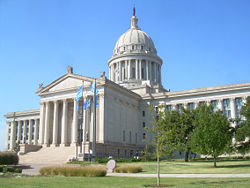- Oklahoma Supreme Court
-
Oklahoma Supreme Court 
The Supreme Court meets in the Oklahoma State CapitolEstablished 1907 Jurisdiction Oklahoma 
United States
Location Oklahoma City, Oklahoma Composition method Gubernatorial appointment with non-partisan statewide retention Authorized by Oklahoma Constitution Decisions are appealed to Supreme Court of the United States Judge term length Life, renewable every 6 years Number of positions 9 Website www.oscn.net Chief Justice Currently Steven W. Taylor Since 2011 Lead position ends 2013 Jurist term ends 2016 Oklahoma 
This article is part of the series:
Politics and government of
OklahomaConstitutionExecutiveLegislatureJudiciaryElectionsDivisionsFederal Relations
The Supreme Court of Oklahoma is one of the two highest judicial bodies in the U.S. state of Oklahoma and leads the Oklahoma Court System, the judicial branch of the government of Oklahoma.[1]
The Oklahoma Supreme Court meets in the Oklahoma Capitol Building in Oklahoma City, Oklahoma.[2]
Contents
Composition
The court consists of the Chief Justice of Oklahoma, a Vice-Chief Justice, and seven Associate Justices, who are nominated by the Oklahoma Judicial Nominating Commission and are appointed by the Governor. After appointment, the justices serve until the next general state election. At that time, they must face a retention election. If retained, they begin a six-year term. After their first term, justices must file for direct election from the people of Oklahoma to retain their position.[3][4]
Unlike the Supreme Court of the United States, the Oklahoma Constitution specifies the size of the Supreme Court. However, the legislature maintains the power to fix the number of justices. According to Article VII, section 2 of the Oklahoma Constitution, the Supreme Court shall consist of nine justices, one justice from each of the nine judicial districts of the State.
Qualification, nomination, appointment and tenure of justices
Each justice, at the time of his or her election or appointment, must be at least thirty years old, a registered voter in the Supreme Court judicial district they represent for at least one year before filing for the position, and a licensed practicing attorney or judge (or both) in Oklahoma for five years before appointment. The potential justice must maintain certification as an attorney or judge during his or her tenure in office in order to main their position.[3]
Potential justices who meet these requirements must submit their names to the Oklahoma Judicial Nominating Commission (JNC) to verify that they will serve if appointed. In the event of a vacancy on the Supreme Court, after reviewing potential justices, the JNC shall submit three names to the Governor, of whom the governor appoints one to the Supreme Court to serve until the next general state election. However, if the governor fails to appoint a justice within sixty days, the Chief Justice of Oklahoma may appoint one of the nominees, who must certify their appointment to Secretary of State of Oklahoma.[5]
Each time a Justice of the Supreme Court is elected to retain his or her position in the general state elections, he or she continues to serve for another six years in office with a term beginning on the second Monday in January following the general election. Justices appointed to fill vacancies take office immediately and continue to serve in their appointed posts until the next general election. To be eligible to stand for reelection, justices must, within sixty days before the general election, submit their desire to stand for reelection to the Secretary of State.[6]
The justice is then put to election by the people of Oklahoma. If the majority votes to maintain the justice, the justice will serve for another six-year term. However, if the justice declines reelection or the voters vote the justice down, the seat on the Supreme Court shall be considered vacant at the end of the current term and the Judicial Nominating Committee must search for a potential replacement. Justices who have failed to file for reelection or were not retained by the people in the general election are not eligible to immediately succeed themselves.[6]
Retention in office may be sought for successive terms without limit as to number of years or terms served in office.[6]
Jurisdiction and powers
Section 4 of Article VII of the Oklahoma Constitution outlines the jurisdiction of the Supreme Court of Oklahoma. The appellate jurisdiction of the Supreme Court is co-extensive with that of the state's borders. The Court's jurisdiction applies to all cases "at law and in equity," except criminal cases, in which the Court of Criminal Appeals has exclusive appellate jurisdiction. If in any event there is any conflict in determining which court has jurisdiction, the Supreme Court is granted the power to determine which court has jurisdiction, with no appeal from the Court’s determination.[1]
Along with Texas, Oklahoma is one of two states to have two courts of last resort; the Oklahoma Supreme Court decides only civil cases, and the Oklahoma Court of Criminal Appeals decides criminal cases. The Oklahoma Supreme Court has only immediate jurisdiction with respect to new first-impression issues, important legal issues, and cases of great public interest.[7][1] In addition to appeals from the trial courts, the Oklahoma Supreme Court has jurisdiction over all lower courts, excluding the Oklahoma Court on the Judiciary, and the Oklahoma Senate, when that body is sitting as a Court of Impeachment. Judgments of the Oklahoma Supreme Court with respect to the Oklahoma Constitution are considered final.[8][9]
This authority includes the power to temporarily assign any judge to a court other than that for which he was selected. The Supreme Court also maintains the power to appoint an administrative director and staff. This director serves at the pleasure of the Court to assist the Chief Justice in his administrative duties and to assist the Court on the Judiciary when the Court on the Judiciary calls upon the office’s administrative powers.[10]
The Supreme Court has power to issue, hear and determine writs of habeas corpus, mandamus, quo warranto, certiorari, prohibition and such other remedial writs as may be provided by law and may exercise such other and further jurisdiction as may be conferred by statute. Any justice on the Court make issue the writ of habeas corpus to any person held in custody upon petition by or on behalf of that person. Such writs can be made to appear before the justice who wrote it, the Oklahoma Supreme Court (or other Appellate Courts), any District Court, or any judge in the State.[1]
Aside from hearing cases, the Supreme Court is also responsible for administering the state's entire judicial system, establishing rules of operation for all other courts in the state. The Supreme Court formulates the rules for the practice of law, which govern the conduct of all attorneys, and it administers discipline in appropriate cases. Additionally, many of the justices make personal appearances to speak to members of the bar, civic clubs, and educational groups. These appearances are made to help citizens understand the Court's workings and decision-making process. Justices are also called upon to administer official oaths of office to public officials.[11]
Ethics Restrictions
Judicial officers are charged with maintaining the integrity and independence of the judiciary. All justices and judges are required to be nonpartisan and are forbidden from using their office or powers to promote or assist any private interest. To maintain their non-partisanship, justices and judges may not hold offices in political parties; make speeches for candidates; or make, directly or indirectly, contributions to campaigns of any candidate for any elected or appointed office.[12]
Justices and judges are also forbidden from campaigning for their own reelection unless there is an active opposition to their retention of office. Even if a justices or judges are actively campaigning for retention, they can not personally raise funds for their campaign.
Current membership
The Justices of the Oklahoma Supreme Court are:
Justice District Appointed Governor Law School Birth City Chief Justice Steven Taylor 2nd 2004 Brad Henry University of Oklahoma Henyretta, OK Vice-Chief Justice Tom Colbert 6th 2004 Brad Henry University of Oklahoma Oklahoma City, OK Yvonne Kauger 4th 1984 George Nigh Oklahoma City University Colony, OK Joseph Watt 9th 1992 David Walters University of Texas Austin, Texas James Winchester 5th 2000 Frank Keating Oklahoma City University Clinton, OK James Edmondson 7th 2003 Brad Henry Georgetown University Kansas City, MO John Reif 1st 2007 Brad Henry University of Tulsa Skiatook, OK Doug Combs 8th 2010 Brad Henry Oklahoma City University Shawnee, OK Noma Gurich 3rd 2011 Brad Henry University of Oklahoma South Bend, IN List of former justices
- Robert L. Williams, (1907-1914), first Chief Justice and third Governor of Oklahoma
- Charles M. Thacker, (1915-1918)
- James B. Cullison, (1928-1934)
- Charles Swindall, 1929-1934
- William A. Berry, (1958-1978)
- Ralph B. Hodges, (1965-2004)
- Robert D. Simms, (1972-1999)
- Alma Wilson, (1982-1999)
- Hardy Summers, (1985-2003)
- Daniel Boudreau, (1999-2004)
- O. A. Cargill, (?-?)
- Robert E. Lavender, (1966-2007)
- Marian P. Opala, (1978-2010)
- Rudolph Hargrave, (1978-2010)
External links
- Oklahoma Supreme Court official homepage
- Oklahoma State Courts Network
- Voices of Oklahoma interview with Marian Opala. First person interview with Marian Opala conducted on October 6, 2010 — four days before his death. Original audio and transcript archived with Voices of Oklahoma oral history project.
References
- ^ a b c d Okla Const. art. VII, § 4
- ^ Okla Const. art. VII, § 5
- ^ a b Okla Const. art. VII, § 2
- ^ Okla Const. art. VII, § 3
- ^ Okla Const. art. VIIB, § 4
- ^ a b c Okla Const. art. VIIB, § 2
- ^ Oklahoma State Court Network. "The Oklahoma Appellate Courts". http://www.oscn.net/oscn/schome/appellate.htm. Retrieved 2010-04-21.
- ^ Okla Const. art. VIIA, § 7
- ^ Okla Const. art. VIII, § 3
- ^ Okla Const. art. VII, § 6
- ^ Oklahoma State Court Network. "The Supreme Court and the Judicial System". http://www.oscn.net/oscn/schome/judicialsystem.htm. Retrieved 2010-04-21.
- ^ Okla Const. art. VIIB, § 6
Coordinates: 35°29′32″N 97°30′12″W / 35.4922820°N 97.5033722°W
Highest judicial bodies in the United States Federal court State supreme courts Alabama · Alaska · Arizona · Arkansas · California · Colorado · Connecticut · Delaware · Florida · Georgia · Hawaii · Idaho · Illinois · Indiana · Iowa · Kansas · Kentucky · Louisiana · Maine · Maryland · Massachusetts · Michigan · Minnesota · Mississippi · Missouri · Montana · Nebraska · Nevada · New Hampshire · New Jersey · New Mexico · New York · North Carolina · North Dakota · Ohio · Oklahoma (Civil) (Criminal) · Oregon · Pennsylvania · Rhode Island · South Carolina · South Dakota · Tennessee · Texas (Civil) (Criminal) · Utah · Vermont · Virginia · Washington · West Virginia · Wisconsin · WyomingTerritorial supreme courts Obsolete Complete list Courts of the United States (Federal and state, all levels)Categories:- State supreme courts
- Government of Oklahoma
- Oklahoma state courts
Wikimedia Foundation. 2010.
